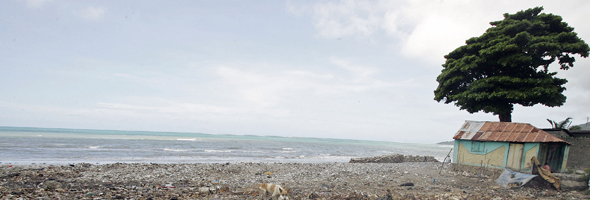Research Brief
Growth for Low-Income Countries?
Even the most optimistic analyses accept that many low-income countries (LICs) will remain low income for some time to come. Consequently, when assessing the policy options available to LICs it is important to take a long term view. In the WIDER Working Paper ‘Aid, Fiscal Policy, Climate Change, and Growth’ David Bevan sets out to highlight some important considerations that should help structure the answer to a crucial question relating to the long term policy options of LICs; first, what determines growth in LICs, and how is the answer conditioned by a country’s history of fiscal policy design?
Environmental issues and growth
There are two types of environmental issue which are particularly important to developing countries. The first concerns environmental degradation and water stress caused by increasing populations and economic development. The second reflects the consequences of global warming, including an increase in climatological disasters in the short term, and changing levels of temperature, rainfall and sea level in the long term.
Bevan suggests that climate change will not be as costly for LICs as one might expect. An ambitious World Bank economic research project entitled ‘The Economics of Adaption to Climate Change’ suggests that the costs of climate change will fall in the range of 0.12 per cent to 0.17 per cent of the aggregate developing country GDP over the period 2010-50. This is by no means insignificant, but Bevan suggests that it is unlikely to be a game changer when compared to the challenges LICs already face. Furthermore while it may seem logical that the problem of water stress will be made worse by climate change, recent studies do not support this; increased water stress is primarily due to increased withdrawals, while increased precipitation due to climate change actually decreases water stress.
Bevan is not seeking to deny the gravity of climate change; he is instead suggesting that the growth consequences to LICs are likely to be small in relative terms over the next few decades. Consequently other environmental concerns such as water stress and environmental degradation are more urgent challenges for LICs, at least in the short term.

What determines growth in low-income countries?
Having established that climate change is not a major impediment to growth in LICs at this time Bevan turns to look at other factors that may determine growth. A LIC with the median per capita income for the group ($440) would have to have a growth rate of seven per cent for 17 years to exit the LIC category. If the growth rate was only five per cent it would take 29 years. Clearly, Bevan suggests, understanding what determines growth in low-income countries is crucial to understanding how LICs can become middle income countries. The focus here is on fiscal considerations; other important determinants of growth, such as the quality of institutions and of governance, are not addressed.
- The infrastructure deficit
One key limitation on growth in low-income countries is that many of them, especially those in Africa, have a huge infrastructure deficit. Bevan argues that this deficit exists for three reasons. First, stabilization efforts have required countries to cut costs to reduce fiscal deficits. It is much harder to reduce current expenditures than it is to reduce expenditure on infrastructure, and the bulk of adjustment was consequently borne by the latter. Second, donors have become increasingly focused on social sector spending and infrastructure has become neglected in aid budgets. Third, infrastructure is simply very expensive and the low-income levels of the countries involved mean that even when a higher than average portion of GDP is dedicated to infrastructure, spending is still low.
All of these problems are compounded by the sheer scale of spending that is needed in order to bring Africa’s infrastructure up to scratch. It is estimated that the region needs to spend around 15 per cent of its GDP on infrastructure, and this is a figure which includes the middle income and resource-rich countries in the region. Bevan suggests that this level of spending is very unlikely to be achieved, and that consequently prioritization will be an important part of selecting policy options for LICs.
- Public debt
Another factor that has the potential to limit growth in LICs is public debt. A particular problem Bevan highlights is that of ‘debt overhang’, a situation where a country’s debt service burden is so high there is little incentive to invest. The level of debt at which this problem starts to be significant is not clear. High estimates put the problematic ratio at around 40 per cent of GDP, whereas others estimate that problems could begin to occur with a debt/GDP ratio as low as 15 per cent. One thing that is clear is that determining a prudent approach to debt is country-specific. LICs need to take into account their own prospects, history, reputation, the costs of borrowing, and the potential for those costs to change in the future when deciding how much debt they can afford to take on.
- The role of government
Bevan notes that as per capita income rises countries will typically experience structural changes. In particular income growth typically leads to a shift in the composition of production between agriculture, manufacturing, and services. There are two options open to a government faced with this type of structural change. First, they could continue to operate as normal, concerning themselves only with core government functions and leaving it up to the private sector to implement the structural changes. Second, the government could take an active role in modifying the characteristics of the transition by, for example, investing in training more workers with skills suitable for the service sector or by identifying and addressing potential bottlenecks.

- The size of the state
Another key factor that effects growth in LICs is the size of the state. Bevan points out that a state can either be too big or too small when it comes to assessing economic efficiency. He argues that there are two important questions that need to be answered. First, what should be the size and functions of the state? Second, are the present fiscal arrangements for achieving these functions sustainable? Bevan suggests that the answers to these questions are likely to be country-specific, and will not be stationary; the scale and scope of government expenditure will change over time and be affected by a wide variety of factors.
Bevan’s paper clearly demonstrates that the determinants of growth in LICs are numerous, and long-term in nature. While climate change is not a major impediment to growth, other environmental concerns such as water stress and land degradation do play a role. Other determinants include the infrastructure deficit, public debt, the role of government, and the size of the state. In the second half of his paper, summarised here, Bevan goes on to suggest ways in which developing countries can look to finance their development going forward.
 Join the network
Join the network